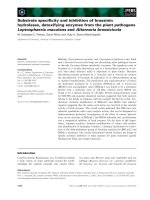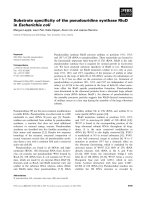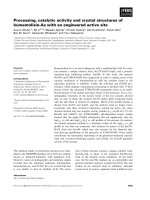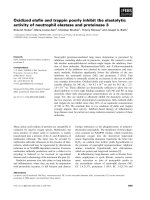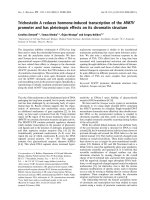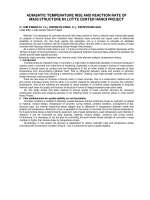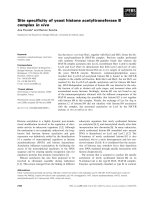Báo cáo khoa học: Substrate specificity and transport mode of the proton-dependent amino acid transporter mPAT2 potx
Bạn đang xem bản rút gọn của tài liệu. Xem và tải ngay bản đầy đủ của tài liệu tại đây (420.98 KB, 8 trang )
Substrate specificity and transport mode of the proton-dependent
amino acid transporter mPAT2
Martin Foltz, Carmen Oechsler, Michael Boll, Gabor Kottra and Hannelore Daniel
Molecular Nutrition Unit, Center of Life and Food Sciences, Technical University of Munich, Germany
The P AT2 t ransporter h as been shown to act as an electro-
genic proton/amino acid symporter. The PAT2 cDNA has
been cloned from various human, mouse and rat tissues and
belongs to a group of four genes ( pat1 to pat4)withPAT3
and PAT4 still resembling orphan transporters. The first
immunolocalization studies demonstrated that the PAT2
protein is f ound in the murine central ner vous system in
neuronal cells with a p roposed role in the intra and/o r
intercellular amino acid transport. Here we provide a
detailed analysis of the transport mode and substrate s pe-
cificity of the murine PAT2 transporter after expression in
Xenopus laevis oocytes, by e lectrophysiological techniques
and flux studies. The structural requirements to the PAT2
substrates – when considering both low and high affinity
type substrates – are similar to those reported for the PAT1
protein with the essential features o f a free carboxy group
and a small side c hain. For high affinity binding, however,
PAT2 requires the amino group to be located in an a-posi-
tion, tolerates only one methyl function attached to the
amino g roup and is h ighly selective for the
L
-enantiomers.
Electrophysiological analysis revealed pronounced effects of
membrane potential on proton binding affinity, but sub-
strate affinities and maximal transport currents only m od-
estly respond to changes in membrane voltage. Whereas
substrate affinity is dependent on extracellular pH, proton
binding affinity to PAT2 is s ubstrate-independent, favouring
a sequential binding of proton followed by substrate.
Maximal transport currents are substrate-dependent which
suggests that the translocation of the loaded carrier to the
internal side is the rate-limiting step.
Keywords: electrophysiology; functional characterization;
proton symporter; substrate recognition; transport mode.
The proton/amino acid transporter family PAT (SLC36)
has been identified from human, mouse and rat origin
during the last three years [1–7]. The PAT family is
comprised of four members ( PAT1–PAT4, SLC36A1–4);
the PAT proteins consist of a round 470–500 amino acids
and are thought to r epresent integral membrane proteins
with a > 60% similarity to each other [8]. The orthologous
proteins from mouse, rat and human show an identity of
more than 90% to each other. The expression pattern of the
four different transporter m RNAs is quite differen t. The
PAT1 mRNA shows widespread expression with high levels
in brain, intestine and kidney whereas the PAT2 mRNA is
highly abundant in lung, kidney a nd brain. PAT3 mRNA
is found solely in testis, whereas PAT4 mRNA shows
ubiquitous expression [8].
So far, only PAT1 a nd PAT2 have been characterized
functionally. They have an exceptional position among the
mammalian amino acid transporters, as they act as electro-
genic amino acid /proton symporters. Transport is depend-
ent on the extracellular pH, but is independent of so dium,
chloride, and potassium ions [1,2,4,7]. Moreover, PAT1 and
PAT2 mediated amino acid i nflux leads to a pronounced
intracellular a cidification [2,9] by cotransport o f t he zwit-
terionic amino acid substrates and protons with a stoichio-
metric coupling of 1 : 1 as shown for the model substrate
L
-proline [2]. Substrates of both transporters are the small
apolar amino acids glycine,
L
-alanine, and
L
-proline [1,2,4–
8]. B esides these c ommon f unctio nal p roperties, distinct
differences became obvious within substrate recognition
and electrophysiological characteristics of the two trans-
porters. PAT2 represents the high affinity transporter type
with ap parent K
m
values for its substrate i n t he range
of 100–700 l
M
, whereas those of PAT1 are in the range of
1–15 m
M
[2,7,9,10]. PAT1 recognizes, besides
L
-a amino
acids, a number of additional substrates, e .g. b-alanine,
c-aminobutyrate (GABA), betaine,
D
-Ser, and
D
-Ala
[1,2,5,6,9], whereas for the PAT2 transporter only sarcosine
has been identified as an additional high a ffinity substrate
beside the normal
L
-a amino acid substrates [2,10].
Recent studies on PAT1 suggest it to play a dual role in
mammalian cells [8]. Based on its localization in lysosomal
membranes in neurons [1,6] i t i s considered to act as an
export system for amino acids out of lysosomes after their
intralysosomal release from proteolytic processes. However,
in in testinal epithelial cells PAT1 is responsible for the
proton-dependent absorp tion of s mall amin o acids and
derivatives in the small intestine, as shown by its endo-
genous functional expression in the apical membrane of the
human intestinal cell line Caco-2 [4,11]. In c ontrast, the
Correspondence to H. Daniel, Center of Life and Food Sciences,
Technical University of Munich, Hochfeldweg 2, D-85350 Freising-
Weihenstephan, Germany. Fax: + 49 8161 71 3999,
Tel.: + 49 8161 71 3400, E-mail:
Abbreviations: GABA, c-aminobutyrate; PAT, proton/amino acid
transporter; mPAT2, murine proton/amino acid transporter 2;
OH-Pro,
L
-4-hydroxyproline; I–V, current–voltage.
(Received 7 May 2004, revised 21 June 2004, accepted 24 June 2004)
Eur. J. Biochem. 271, 3340–3347 (2004) Ó FEBS 2004 doi:10.1111/j.1432-1033.2004.04268.x
physiological role of the PAT2 transporter is c urrently not
known. We previously reported the PAT2 protein expres-
sion pattern in the mouse brain [10] and demonstrated that
it is highly expressed in N-methyl-
D
-aspartate receptor
positive neuronal cells throughout the central nervous
system. The subcellular localization d iffers markedly from
that of PAT1 in neuronal cells with a lack of detection in
lysosomes, but localization in recycling endoso mes and
endoplasmatic reticulum. Whether the endoplasmatic reti-
culum localization i s due to a specific role of PAT2 in this
compartment or whether it just represents newly synthesized
transporters is not clear yet. T he localization in r ecycling
endosomes suggests a possible insertion of PAT2 into the
neuronal plasma m embrane and we proposed PAT2 as a
candidate protein for the still missing Na
+
-independent low
affinity glycine transport system in the central nervous
system [12,13]. PAT2 could be responsible, along with the
high affinity glycine transporters GLYT1 and GLYT2, for
the regulation of intracellular and extracellular concentra-
tions of glycine that modulate glycinergic and glutamatergic
neurotransmission [14,15]. Moreover, Bermingham et al.
suggested a role for PAT2 in the differentiation of Schwann
cells in rat sciatic nerves [3]. In other tissues than the nervous
system, cellular and subcellular expression pattern o f the
PAT2 protein have not been examined so far, although the
mRNA is expressed i n various organs such as in lung,
kidney, and heart [2,5,7].
To get a better understanding of the phys iological function
of the PAT2 transporter in the various cell types and
organelles, we here provide a detailed functional analysis of
the murine PAT2 (mPAT2) protein when e xpressed in
Xenopus laevis oocytes. We e xploredthesubstraterecognition
parameters and describe the critical features for high affinity
substrate b inding. M oreover, we demonstrate t hat there is no
proton-leak pathway a nd that the kinetic parameters depend
on the membrane potential and the proton electrochemical
gradient that in turn support the existence of a n ordered
binding mechanism for protons and substrate.
Materials and methods
Materials
All e xperime nts w ith Xenopus laevis followed our institu-
tional guidelines for care and handling of laboratory
animals, in full agreement with the German guidelines,
and the studies were approved by the state ethics committee.
Xenopus laevis frogs were purchased from Nasco ( Fort
Atkinson, WI, USA). Amino acids and related compounds
were obtained from Sigma Chemie (Deisenhofen, Germany)
or Merck (Darmstadt, Germany) of pro analysi quality.
Salts and all other chemicals were obtained from Sigma and
Carl Roth AG (Karlsruhe, Germany) of pro analysi quality.
L
-[3,4-
3
H]proline (specific a ctivity 60 CiÆmmol
)1
) was pur-
chased from ICN (Irvine, CA, USA). Collagenase A was
obtained from Roche Molecular Biochemicals (Mannheim,
Germany).
Xenopus laevis
oocytes handling and cRNA injection
Oocytes were treated with collagenase A (Roche Diagnos-
tics) f or 1.5–2 h at room temperature in C a
2+
-free ORII
solution (82.5 m
M
NaCl, 2 m
M
KCl, 1 m
M
MgCl
2
and
10 m
M
Hepes, pH 7.5) to remove follicular cells. After
sorting, healthy oocytes of stage V and VI were kept at
18 °C in m odified Barth solution containing 88 m
M
NaCl,
1m
M
KCl, 0.8 m
M
MgSO
4
,0.4m
M
CaCl
2
,0.3m
M
Ca(NO
3
)
2
,2.4m
M
NaHCO
3
and 10 m
M
Hepes (pH 7.5).
The next day oocytes were injecte d with 27 nL sterile water
(control) or 27 nL mPAT2-cRNA (27 ng cRNAÆoocyte
)1
).
The oocytes were kept in modified Barth solution at 18 °C
until further use (3–5 d ays after injection).
Amino acid uptake
Ten oocytes (water- or cRNA-injected) per uptake experi-
ment were preincubated at room temperature for 2 min in
Na
+
-free standard uptake buffer (100 m
M
choline chloride,
2m
M
KCl, 1 m
M
MgCl
2
,1m
M
CaCl
2
,10m
M
MES
pH 6.5). The buffer was then replaced by the respective
uptake buffer supplemented with 100 l
ML
-proline inclu-
ding
L
-[3,4-
3
H]proline as a tracer (5 lCiÆmL
)1
) without
(control) or with the addition of 10 m
M
of the test
compounds. After 10 min of incubation, the oocytes were
washed three times with 3 mL of ice cold uptake buffe r and
immediately distributed to individual vials. After oocyte
lysis in 10% (w/v) SDS, radioactivity was counted by liquid
scintillation.
Two-electrode voltage clamp
Two-electrode voltage clamp e xperimen ts were performed
as described previously [2]. Briefly, the oocyte was placed in
an open c hamber and continuously superfused with incu-
bation buffer (100 m
M
choline c hloride, 2 m
M
KCl, 1 m
M
MgCl
2
,1m
M
CaCl
2
,10m
M
MES or HEPES at pH 5.5–
8.5) in the absence or presence of amino acids. Oocytes were
voltage clamped at )60 mV, a nd current–voltage (I–V)
relations were measured using short (100 ms) pulses separ-
ated by 200 ms pauses in the potential range )160 to
+80 m V. I–V measurements w ere made immediately
before and 20–30 s after substrate application when current
flow reached steady state. The current evoked by PAT2 at a
given m embrane poten tial was calculated as the difference
between the c urrents measured i n the presence and the
absence of substrate. Substrate concentration kinetics were
constructed from experiments employing five different
amino acid c oncentrations in Na
+
-free buffer at pH 6.5
with five to seven individual mPAT2 expressing oocytes
from at least two different oocyte batches for each substrate.
The buffer pH of 6.5 was chosen to measure under full
proton saturating conditions and additionally to ensure
high enough inward currents even at lower expression level.
Substrate-evoked currents w ere t ransformed according to
Eadie–Hofstee and after linear regression the apparent
substrate concentrations that cause half-maximal transport
activity (apparent K
m
) were d erived. Kinetics of s ubstrate
transport as a function of external proton concen tration
(apparent proton activity) were performed under substrate
saturation with either 20 m
M
alanine or proline. The
standard incubation medium was buffered with 10 m
M
Tris
and adjusted to pH values between pH 7.5 and pH 9.0. The
apparent K
m
values for proton binding were derived by
linear regression after Eadie–Hofstee transformation of
Ó FEBS 2004 Functional properties of mPAT2 (Eur. J. Biochem. 271) 3341
inward currents induced by six different external pH values.
Data points in all cases could be best-fit by linear regression
analysis after transformation according to Eadie–Hofstee to
a s ingle k inetic term excluding the possibility t hat k ine tic
parameters are s ubstantially affected by unspecific proton
binding effects or via an allosteric proton binding site.
Statistics
All calculations (linear as well as nonlinear regression
analyses) w ere performed using
PRISM
software (ver sion
4.01, GraphPad, San Diego, CA, USA). Data are presented
as mean ± SEM. I f error bars are not visible w ithin the
graphs, they are smaller than the symbols. Statistically
significant differences were determined using ANOVA
analysis followed b y Newman–Keuls multiple comparison
test.
Results
To elucidate the minimal structural requirements which
determine the high affinity phenotype of PAT2 a set of
amino acids and derivatives divided into different categories
with differences in (a) side chain size, (b) backbone length,
(c) O- and N-methyl substitutions, (d) stereochemistry and
(e) polarity were analysed.
The size of the amino acid side chain was shown to be
a critical determinant for substrate interaction with PAT2.
Only glycine and alanine were a ble to induce comparable
inward currents in oocytes expressing PAT2 with a h igh
affinity interaction ( Fig. 1A and Table 1). T he elongation
of the side chain by just by one CH
2
unit leading to
L
-a-
amino butyric acid led to a dramatic decrease in substrate
affinity and t ransport currents ( Table 1) and further side
chain elongations completely abolished substrate–
PAT2 interactions (Table 1). T he intramolecular d istance
between the c harged amino- and c arboxy-head groups is
an even stronger recognition criterion for high affinity.
The introduction of one CH
2
unit as in b-alanine
substantially reduced PAT2-mediated inward currents
paralleled by a pronounced decline in affinity, when
compared to glycine or alanine (Table 1). Whereas a
further elongation of the backbone as in GABA further
decreased inward currents and affinity, d-aminopentanoate
or e-aminohexanoate failed to induce any transport
currents (Table 1). Methyl-substitutions at the a mino- o r
carboxy-group of the a-amino acids had a differential
effect on substrate a ffinity and transport by PAT2.
O-methyl esters of glycine or alanine do not serve as
substrates whereas a single N-methylation a s in sarcosine
is well tolerated as shown by high affinity interaction and
high transport c urrents. However incorporation of a
second and third methyl moiety at the amino group as in
N,N-dimethylglyc ine and b etaine led t o a sequential
reduction in PAT2 transport currents as well as markedly
lower b inding affinity (Fig. 1C and Table 1).
PAT2 does not discriminate completely between
D
-amino
acids as substrates but shows a structure-dependent enan-
tioselectivity. O ut of the tested
D
-amino acids, only
D
-pro-
line was able to interact in a high affinity mode,
D
-serine and
D
-alanine displayed much lower affinities and for
D
-cysteine
no interaction was been observed (Table 1). Interestingly,
transport currents of the three interacting
D
-amino a cids are
not very different to each other despite quite marked
differences in affinity, but were substan tially lower to those
of the reference substrate glycine. This is striking in the case
Fig. 1. Substrate specificity of mPAT2. (A,B) Representative current traces of oocytes expressing mP AT2 in response to perfusion with 20 m
M
of
the different substrates in Na
+
-free buffer at pH 6.5. (C,D) Inhib ition of [
3
H]proline uptake by
L
-a-amino acids with increasing side chain length
(C) or various N -methylated glycines (D). Data re present the specific P AT2-mediated p roline u ptake i n t he ab sence ( fi lled bar) o r p resenc e ( hatched
bars) of 10 m
M
of competing test com pound in Na
+
-free buffer at pH 6.5 (mean ± SEM, n ¼ 6–8); ***, P<0.001.
3342 M. Foltz et al.(Eur. J. Biochem. 271) Ó FEBS 2004
of praline, with 30% of maximal glycine currents at 20 m
M
concentration and a fairly high affinity of 0.25 ± 0.09 m
M
.
This may be interpreted as the first evidence for a restricted
velocity in the translocation step of the loaded transporter
by the sterical conformation of the substrate.
The introduction of polar side groups in the aliphatic
a-amino acids led to dramatic decreases in transport
currents and affinity, as shown f or
L
-cysteine and
L
-serine
(Table 1). However, the polar residue in
L
-4-hydroxy-
proline (OH-Pro) was able to interact in a high affinity
mode, although transport currents were substantially smal-
ler when compared t o t hose o f glycine. We also studied the
potency of various compounds for inhibition of PAT2-
mediated proline uptake i n Xenopus laevis oocytes. The
inhibition rates w ere in c lose relationship t o the apparent
affinities as determined by electrophysiology, as shown for
a-amino acids with increasing side chain length as well as for
the N-methylated glycines (Fig. 1C,D). This correlation was
also observed with all other tested amino acids (Table 1).
Concentration dependent substrate induced transport
currents always followed single component saturation
kinetics, as shown for
D
-proline and b-alanine (Fig. 2).
Substrate affinities were, for most compounds, only mod-
estly d ependent or independent on changes i n m embrane
potential (Fig. 3A). The apparent K
m
values of
D
-Pro,
D
-Ala and OH-Pro increased only 1.5- and 2.1-fold by
depolarizing the membrane from )120 to )20 mV. On the
other hand, the affinity of b-Ala did not change significantly
within this potential range. Maximal transport currents for
the various substrates are essentially independent of the
membrane potential (Fig. 3B) with changes of less than
30% by alterations of membrane voltage from )120 to
)2 0 mV for all tested substrates.
Next, we addressed the question of whether the substrate
affinity depends on extracellular pH, by determining the
apparent K
m
values of glycine and a lanine at pH values of
pH 5.5–8.5 (Fig. 4) and a broad range of membrane
potentials. At hyperpolarized membrane potentials K
m
values of glycine and alanine were r elatively i nsensitive
towards voltage (Fig. 4A,B). W hen in creasing the pH in the
extracellular medium, voltage dependence of the K
m
values
became pronounced with a s evere reduction i n affinity at
Table 1. A pparent substrate affinities and transport currents of amino acids and derivatives as well as the corresponding inhibitory effect on the uptake
of the r adiolabelled tracer proline a s d etermined f or mPAT2 after expression in Xenopus oocytes. Substrate dependent inward currents as a function of
substrate concentration were recorded and transformed ac cord ing to Ead ie– Hofste e to deriv e the appar ent K
m
valuesbylinearregression analysis.
Data are presented as the mean ± SE M o f n ¼ 5–7 oocytes in each experiment. %I
20 mM
(I
Gly
¼ 100%), data are presented as normalized currents
(mean ± SEM, n ¼ 5–7 ) for every test c ompou nd at 20 m
M
relative to the maximal currents of 20 m
M
glycine at pH 6.5 and at a membrane
potential of )60 mV. Comp ounds with an I
20 mM
not higher than backgroun d values as observed in w ater-injected ooc ytes ( P >0.05,Students
paired t-test) are given as < 5%. Uptake of
L
-[
3
H]proline (100 l
M
) was measured at pH 6.5 for 10 min in the presence of unlabeled amino acids
and derivatives at a fixed concentration of 10 m
M
andaregivenaspercentageinhibitionofthecontroluptakemeasuredintheabsenceofinhibiton.
Data are means ± SEM (n ¼ 8–10). ND, not determined.
Substrate Apparent K
m
value (m
M
)%I
20 mM
(I
Gly
¼ 100%) % Inhibition of control uptake
Elongation of the side chain
glycine 0.59 ± 0.04
a
100 90.5 ± 2.3
L
-Alanine 0.25 ± 0.05
a
65.3 ± 2.6
a
95.9 ± 1.5
L
-a-Aminobutyric acid 20.0 ± 1.5 10.6 ± 2.0 25.9 ± 7.3
L
-Norvaline ND < 5 22.9 ± 7.6
L
-Norleucine ND < 5 < 5
Elongation of the backbone
b-Alanine 14.8 ± 2.5 36.6 ± 0.7 59.9 ± 1.3
c-Aminobutyric acid > 25
a
15.3 ± 0.9 28.5 ± 5.7
d-Aminopentanoic acid ND < 5 < 5
e-Aminohexanoic acid ND < 5 10.5 ± 8.4
O-Methyl substitution
O-Methyl-glycine ND < 5 < 5
O-Methyl-alanine ND < 5 6.0 ± 3.4
N-Methylated glycines
Sarcosine 0.21 ± 0.01
a
93.8 ± 3.4 94.3 ± 1.2
N,N-dimethylglycine 14.7 ± 2.4 34.2 ± 2.5 55.3 ± 5.4
Betaine > 25 9.4 ± 1.9 26.9 ± 7.0
D
-Enantiomers
D
-Alanine 6.5 ± 1.1
a
31.2 ± 1.9 ND
D
-Serine 14.7 ± 0.5 25.4 ± 2.1 ND
D
-Cysteine ND < 5 ND
D
-Proline 0.25 ± 0.09 29.9 ± 0.7 ND
Polar
L
-a-amino acids
L
-Ser > 25
a
14.5 ± 0.6
a
<5
L
-Cys ND < 5 < 5
L
-4-Hydroxy-proline 0.72 ± 0.10 37.2 ± 1.3 ND
a
K
m
and %I
20 mM
values taken from our previous studies [2,10].
Ó FEBS 2004 Functional properties of mPAT2 (Eur. J. Biochem. 271) 3343
neutral and more alkaline pH values for both amino acids at
a membrane potential of )60 mV (Fig. 4C). This strongly
suggested that the apparent proton concentration (activity)
at the outside substrate b inding domain a ffects substrate
affinity in a voltage-dependent manner. We therefore varied
the extracellular pH from pH 9.0–7.5 at saturating substrate
concentration (20 m
M
alanine or proline) in small pH-steps
and recorded currents i n the membrane potential range
from )140to+20mV.AsshowninFig.5Ainward
currents increased by lowering extracellular pH, and
followed Michaelis–Menten kinetics as a function of exter-
nal proton concentration, as shown for various voltage steps
in Fig. 5B. After Eadie–Hofstee t ransformation, for e ach
recorded membrane potential the apparent proton bin ding
affinity constant (apparent K
m
value) was determined. The
data in all c ases could b e fi tted best to a single kinetics,
almost excluding a significant contribution o f nonspecific
pH-effects and excluding a co-operative (e.g. allosteric)
proton binding mechanism. Apparent proton affinities in
the presence of alanine and proline at )60 mV were as high
as 0.83 ± 0.21 n
M
and 0.49 ± 0.10 n
M
, respectively. These
values correspond to a pH of 9.1 and pH 9.3 and suggest
that PAT2 under physiological conditions at extracellular
pH values of 6.8–7.4 operates essentially independent of pH.
The apparen t proto n binding affinities at a given membrane
potential were independent of the substrate used but highly
dependent on the m embrane potential (Fig. 5 C). A depo-
larization of the oocyte membrane from )120 mV to
)20 mV led to a 10- to 15-fold decrease in apparent proton
affinity in the presence of substrate which suggests that
membrane voltage changes are the most critical parameters
in PAT2-mediated transport in vivo.
To asses whether PAT2 possesses a proton shunt
pathway in the absence of substrate by a channel/pore like
activity in an uncoupled mode, pH jump studies were
performed. Accordingly, membrane potential-dependent
currents in PAT2-expressing oocytes were recorded at
pH 9.0 and pH 7.5 in the absence of any substrate
(Fig. 5D). The I–V relationship did not significantly change
in response to the pH jump. Moreover, the reversal
potential only shifted slightly from )24 mV to )19 mV.
This suggests t hat P AT2 does not have any detectable
proton leakage. In the presence of substrate however, t he
reversal potential shifted markedly to more positive poten-
tials, e.g. from )2 mV to + 20 mV by lowering extracellular
pH from pH 9.0 to pH 8.7 as a measure of substrate-
coupled proton cotransport (Fig. 5A).
Discussion
In previous studies on the s ubstrate recognition pattern of
PAT1 [9] we were able to demonstrate that this
transporter has a broader substrate spectrum that
includes not only t he amino acids glycine, alanine, serine
and proline but also osmolytes such as sarcosine and
betaine, and the
D
-enantiomers of serine and alanine. The
apparent affinities of PAT1 substrates are mainly in the
range of 2–15 m
M
[1,2,4,6,9]. As shown h ere, PAT2 is a
Fig. 2. PAT2-mediated inward currents as a function of substrate con-
centration. PAT 2 expressing oocytes clamped at )60 mV were per-
fused with increasing concentrations (0.25–20 m
M
)of
D
-proline (h)or
b-alanine (s) at an extracellular pH of 6.5. The curves were fitted to a
Michaelis–Menten kinetic by nonlinear regression analysis (R
2
¼ 0.78
and 0.81, respectively). Data represent the mean ± S EM (n ¼ 5).
Fig. 3. Apparent K
m
and V
max
of various amino acids as a function of
the membrane potential in PAT2 expressing oocytes. Membrane
potential dependency of the apparent K
m
(A) and V
max
(B) values of
b-alanine (h),
D
-alanine (n), OH -prolin e (e), and
D
-proline (s)at
pH 6.5. Data repre sent the mean ± SEM (n ¼ 5–7).
3344 M. Foltz et al.(Eur. J. Biochem. 271) Ó FEBS 2004
high affinity type amino acid proton s ymporter that has a
more restrictive specificity. In contrast to PAT1, PAT2
preferentially recognizes a-amino acids, whereas b-alanine
and G ABA are low affinity substrates and b etaine seem s
not to be recognized by PAT2.
When considering both the high (K
m
¼ 0.1–1 m
M
)and
low a ffinity (K
m
¼ 5–15 m
M
) t ype substrates of PAT2 iden-
tified, (a) an unsubstituted negatively charged (carboxy-)
group, (b) the small size of the s ide chain (maximally two
CH
2
units), and (c) a distance not exceeding three CH
2
units
between the charged amino- and carboxy-head groups, are
the common a nd essential substrate features. But PAT2 in
contrast to PAT1 tolerates only one (methyl-) substitution
at the amino group as in sarcosine. Interestingly, all tested
prolines (
L
-Pro,
D
-Pro and
L
-OH-Pro) are recognized as
high affinity substrates by PAT2 with
D
-Pro as the only
D
-amino acid, and
L
-OH-Pro as the only polar amino acid
accepted w ith high affinity. Although only speculative, the
rigid ring structure of proline may cause a different
orientation of the substrate w ithin the substrate binding
site of PAT2, and this may simultaneously avoid the
interference of the polar side ch ain w ith c orresponding
amino acid residues in the binding pocket. Whether other
proline derivates also serve as substrates of PAT2, as
recently shown for its paralog PAT1 [11], is p resently not
known.
Membrane potential and extracellular p H have quite
diverse effects on the kinetics of transport by PAT2.
Maximal transport velocity was only moderately affected by
both membrane potential and extracellular pH within t he
physiological ranges. This appears t o be a unique feature of
PAT2. Similar electrogenic proton-dependent symporters
such as PAT1 (M. Foltz, unpu blished observation) or the
peptide t ransporters PEPT1 do show a much more
pronounced voltage-dep endence of m aximal transport
currents [16].
In contrast to V
max
, apparent substrate affinity strongly
decreased more than 7.5-fold when extracellular pH was
increased from p H 6.5 to pH 8.5. The effect of membrane
potential on substrate affinity is also highly dependent on
extracellular p H. Under proton saturation c onditions
(pH < 7.5), apparent K
m
values were only modestly
(around 2-fold) affected by a voltage change from
)120 mV to )20 mV whereas at pH 8 .5 the voltage effects
became apparent with a s evere reduction in affinity at low
membrane potential. Apparent proton affinity also
decreased substantially by depolarization suggesting that
the lower substrate affinities under nonsaturating external
proton concentrations is mainly a consequence of the
decreased proton activity. The extraordinary high affinity of
protons for binding to PAT2 with less than 1 n
M
at
physiological membrane voltages suggests that pH changes
in the physiological range do not affect transport activity at
all. Moreover, affinity of proton binding is n ot dependent
on substrate, whereas the affinity of the substrate is
significantly dependent on the actual extrac ellular p roton
concentration. This argues for an ordered binding mechan-
ism where the proton b inds before the substrate enters the
binding domain. Proton transfer to the internal membrane
side however, requires t he substrate a s no i ntrinsic proton
leak or uncoupled proton/charge movement could be
observed. A pronounced pH-dependent shift in reversal
potential was observed in the presence of substrate and we
have previously shown that PAT2 couples proton move-
ment to substrate movement with a 1 : 1 flux coupling
stoichiometry. The shift in reversal potential however, was
smaller than t heoretically predicted for cotransport of a
Fig. 4. Subs trate apparent K
m
values as a function of the extracellular
pH. (A,B) Membrane potential dependency of the apparent K
m
values
of glycine (A) and
L
-alanine (B) at t he extracellular p H 8.5 (h), p H 7.5
(n), pH 6.5 (e), and pH 5.5 (s) in PAT2 expressing oocytes. (C)
Apparent K
m
values of glycine (h)and
L
-alanine (s) – depict ed from
(A) and (B) – as a function of the extracellular pH at )60 mV. Data
represent the mean ± SEM (n ¼ 4–7); ***, P<0.001; **, P<0.01
when compared with the corresponding values at pH 7.5.
Ó FEBS 2004 Functional properties of mPAT2 (Eur. J. Biochem. 271) 3345
single positive charge (61 mVÆpH unit
)1
)atanassumed
intracellular pH of about 7.5. This deviation most likely
results f rom r apid changes in i ntracellular p H during the
first 20 s of substrate perfusion before the I–V curves were
recorded, and such a significant decline in intracellular pH
was shown previously by intracellular pH r ecordings [2,9].
Although the data provide evidence for an ordered process
in proton and substrate binding, what appears to be a novel
feature of PAT2 are the quite impressive differences in
maximal transport activity (at least maximal transport
currents) elicited by the different substrates. Most strik-
ingly, substrates with essentially the s ame affinity such as
L
-alanine (0.25 m
M
), sarcosine (0.21 m
M
),
D
-proline
(0.25 m
M
)or
L
-4-OH-Proline (0.72 m
M
)displayI
max
values
of 65 ± 3 , 9 4 ± 3, 30 ± 1 and 37.2 ± 1% of the I
max
currents induced by glycine in the same oocytes (Table 1).
This can only be taken as an indicator that the transloaction
of the loaded transporter to the internal membrane side is
the rate-limiting s tep and not – as proposed for most of the
other electrogenic symporters – the return of the unloaded
transporter to the outside of the membrane [17].
In summary, we show that the mPAT2 protein when
expressed heterologously in Xenopus oocytes has more
restricted substrate specificity and a distinctly different
dependence on membrane potential and pH than its
paralog PAT1. PAT2 in its physiological setting is
predicted to operate independent of pH by its e xtremely
high external proton binding affinity, and substrate
affinity is also only affected via the pH dependence at
depolarized potentials. Maximal t ransport activity i s a lso
only modestly dependent on membrane voltage and p H
but strongly dependent on the substrate. An ordered
proton and substrate binding process is followed by
translocation of the loaded carrier – as the rate-limiting
step – with delivery o f substrate and c otransported ion to
the internal side. The lack of transport of the two
neuroactive compounds
D
-Ser and GABA a ppears par-
ticularly i nteresting with respect t o P AT2 expression in
the mammalian central nervous s ystem [10].
Acknowledgements
This work was supported by the DFG Grant (BO 1857/1) to M. B.
References
1. Sagne
´
, C., Agulhon, C., Ravassard, P., Darmon, M., Hamon, M.,
El Mestikawy, S., Gasnier, B . & Giros, B. (2001) Identification
and characterization of a lysosomal transporter for small neutral
amino acids. Proc. Natl Acad. Sci. USA 98, 7206–7211.
2. Boll, M., Foltz, M., Rubio-Aliaga, I., Kottra, G. & Daniel, H.
(2002) Functional characterization of two novel mam malian
electrogenic proton dependent amino acid cotransporters. J. Biol.
Chem. 277, 22966–22973.
3. Bermingham, J.R. Jr, Shumas, S ., Whisenhunt, T., Sirkowski,
E.E., O’Connell, S., Scherer, S.S. & Rosenfeld, M.G. (2002)
Fig. 5. Proton kinetics in PAT2 expressing oocytes. (A) I –V relationship of P AT2 mediated currents induced b y 20 m
M
alanine at e xtracellular pH 9.0
(h), pH 8.7 (n), pH 8.4 (e), pH 8.1 (s), pH 7.8 (j), and p H 7.5 (d). (B) PAT2 m ediated currents a s a function of the extracellular proton
concentration at various membrane p otentials: 0 mV (j), )20 mV ( m), )40 mV ( r), )60 mV (d), )100 mV (n), an d )140 mV ( s). Data from (A)
were tra nsformed for M ichaelis–Menten presen tation, p H values are expressed as the corresponding proton con centrations. (C) Apparen t K
m
values
of prot ons in the presence of proline (h)and
L
-alanine ( s) as a function of the membrane potential. (D) I–V r elatio nship of n on substrate curre nts in
PAT2 expressing oocytes at different extra cellul ar pH values. Oocytes were perfused with standard Na
+
-free buffer at pH 9.0 (h)andpH7.5(s).
Twenty seconds after p H changes the I–V relation ship was recorded in the absence of substrate. Data represent the mean ± SEM (n ¼ 6).
3346 M. Foltz et al.(Eur. J. Biochem. 271) Ó FEBS 2004
Identification of genes that are downregulated in the abse nce of
the POU domain transcription factor pou3f1 (Oct-6, Tst-1, SCIP)
in sciatic nerve. J. Neurosci. 22, 10217–10231.
4. Chen,Z.,Fei,Y.J.,Anderson,C.M.H.,Wake,K.A.,Miyauchi,S.,
Huang, W., Thwaites, D.T. & Ganapathy, V. (2003) Structure,
function and immunolocalization of a proton-coupled amino acid
transporter (h PAT1) in the human intestinal cell line Caco-2.
J. Physiol. 546, 349–361.
5. Boll, M., Foltz , M ., R ubio-Aliaga, I. & Daniel, H. (2003) A cluster
of proton/amino a cid transporter gen es in the h uman and m ouse
genomes. Genomics 82, 47–56.
6. Wreden, C.C., Johnson, J., Tran, C., Seal, R.P., Copenhagen,
D.R., R eimer, R.J. & Edwards, R.H. ( 2003) The H
+
-coupled
electrogenic lysosomal amino acid transporter LYAAT1 localizes
to the axon and plasma membrane of hippocampal neurons.
J. Neurosci. 23, 1265–1275.
7. Chen, Z ., Kennedy, D.J., Wake , K .A., Zhuang, L., G anapathy, V.
& Thwaites, D.T. (2003) Structure, tissue expression pattern, and
function of the amino acid transporter rat PAT2. Biochem. Bio-
phys.Res.Comm.304, 747–754.
8. Boll, M., D aniel, H. & Gas nier, B. (2004) The S LC36 family:
proton-coupled tran sporters for t he absorp tion of sele cted amino
acids from extracellular and intracellular proteolysis. Pflu
¨
gers
Arch. 447, 776–779.
9. Bo ll, M., Foltz, M., A n ders on, C.M., Oechsler, C., Kottra, G.,
Thwaites, D.T. & Daniel, H. (2003) Substrate recognition by the
mammalian p roton-dependent amino acid transporter PAT1.
Mol. Membr. Biol. 20, 261–269.
10. Rubio-Aliaga, I., B oll, M., Vogt Weisenhorn, D.M., F oltz, M.,
Kottra, G. & Daniel, H. (2004) The proton/amino acid cotrans-
porter PAT2 is expressed in neurons with a different subcellular
localization than its paralog P AT1. J. Biol. Chem. 279, 2754–2760.
11. Metzner, L., Kalbitz, J. & Brandsch, M. ( 2004) Tr ansport o f
Pharmacologically Active Proline Derivatives by the Human
Proton-Coupled Amino Acid Transporter hPAT1. J. Pharmacol.
Exp. Ther. 309, 28–35.
12. Logan, W.J. & S nyder, S.H . (1971) Unique high affinity uptake
systems for glycine, glutamic and aspartic acids in central nervous
tissue of the rat. Nature 234, 297–299.
13. Bennett, J.P. Jr, Logan, W.J. & Snyder, S.H. (1972) Amino acid
neurotransmitter candidates: sodium-dependent high-affinity
uptake by unique synaptosomal fractions. Science 178, 997–999.
14. Guastella, J., Brecha, N., Weigmann, C., Lester, H.A. & Davison,
N. (1992) Cloning, expression, a nd localization o f a r at b rain high-
affinity glycine transporter. Proc. Natl Acad. Sci. USA 89, 7189–
7193.
15. Liu, Q.R., Nelson, H., Mandiyan, S., Lopez-Corcuera, B. &
Nelson, N. (1992) Cloning and expression of a glycine transporter
from mouse brain. FEBS Lett. 305, 110–114.
16. Mackenzie, B., Loo, D.D., Fei, Y.,Liu,W.J.,Ganapathy,V.,
Leibach, F.H. & Wright, E.M. (1996) Mechanisms of the human
intestinal H
+
-coupled o ligopeptide transporter hPEPT1. J. Biol.
Chem. 271, 5430–5437.
17. Jauch, P. & L auger, P. (1986) Electrogenic properties of the
sodium-alanine cotransporter in p ancreatic acinar cells. II. Com -
parison with transport models. J. Membr. Bi ol. 94, 117–127.
Ó FEBS 2004 Functional properties of mPAT2 (Eur. J. Biochem. 271) 3347

